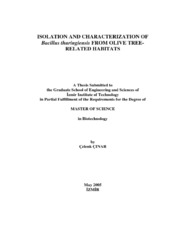Please use this identifier to cite or link to this item:
https://hdl.handle.net/11147/3190| Title: | Isolation and Characterization of Bacillus Thuringiensis From Olive Tree-Related Habitats | Authors: | Çınar, Çelenk | Advisors: | Güneş, Hatice | Publisher: | Izmir Institute of Technology | Abstract: | Abstract:Bacillus thuringiensis (commonlyreferred to as Bt) is a Gram-positive, sporeforming soil bacterium that produces insecticidal crystal proteins during sporulation.These crystals are referred as Bt toxins or -endotoxins. The most important characteristics of the toxins are their insecticidalactivity against many insects. Since their insecticidal potential has been discovered,it has been produced commercially and used as microbial pesticides all over the world.Therefore, the aim of this study was to isolate Btfrom olive tree-related habitats, and to determine the phenotypic andisolate Btfrom olive tree-related habitats, and to determine the phenotypic and genotypic characteristics of the isolates. To accomplish this purpose, 240 samples were collected in the Aegean Region. The phase-contrast microscopy results showed the presence of crystals in 54 environmental samples, corresponding to 100 Bt isolates. The crystal morphologies were spherical, bipyramidal, cuboidal, irregular pointed, and irregular shaped. The greatest proportion of samples yielding this organism was from the soil. The remaining were from olive leaf residue, green olive leaves, animal faeces,dust samples, and olive pomace. The isolates were characterized on the basis of biochemical characters, cry andcyt gene content, plasmid profiling, 16S-ITS rDNA RFLP.Biochemical tests included protease (caseinase and gelatinase), lecithinase, amylase, nuclease, urease, esculinase, arginine dihydrolyse activity; fermentation of sucrose, salicin, mannose, cellobiose, and maltose, production of acetyl-methyl carbinol, methyl red reaction. Polymerase chain reaction (PCR) has been applied for the identification of cry1, cry2, cry4, cry9, cry11, cry13, cyt1, and cyt2 genes. 68% of the isolates amplified cry1 gene; 57% amplified cry4; 20% amplified cry11; 26% amplified cry9; 20% amplified cry2 genes, andnone of the isolates harbored cry13 gene. Cyt1gene was found in 40% of the isolates while cyt2 gene was present in 80% of the isolates. The most abundant genotype of cry genes was cry1 and cry4. Most of the isolates(58%) possessed more than one cry gene. In addition, different combinations of cry andcytgenes were obtained. Plasmid profiling showed the presence of plasmids in all isolatesand the number of plasmids was usually morethan one. Also, the discrimation effect of 16S-ITS rDNA RFLP was tested to differentiate certain isolates and reference strains, which showed similar biochemical characteristics. | Description: | Thesis (Master)--Izmir Institute of Technology, Biotechnology, Izmir, 2005 Text in English; Abstract: Turkish and English xii,115 leaves |
URI: | http://hdl.handle.net/11147/3190 |
| Appears in Collections: | Master Degree / Yüksek Lisans Tezleri |
Files in This Item:
| File | Description | Size | Format | |
|---|---|---|---|---|
| T000318.pdf | MasterThesis | 10.08 MB | Adobe PDF |  View/Open |
CORE Recommender
Page view(s)
328
checked on Jun 16, 2025
Download(s)
230
checked on Jun 16, 2025
Google ScholarTM
Check
Items in GCRIS Repository are protected by copyright, with all rights reserved, unless otherwise indicated.